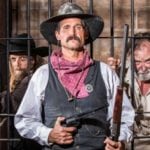 Movies and TV
Movies and TV  Movies and TV
Movies and TV  Humans
Humans 10 Times Scientists Were Absolutely Sure… and Absolutely Wrong
 Our World
Our World 10 Pivotal Moments for Life on Earth
 Movies and TV
Movies and TV 10 Most Realistic Medical TV Shows of All Time
 Creepy
Creepy 10 Eerie & Mysterious Ghosts of the Pacific Coast
 Weird Stuff
Weird Stuff 10 Typos That Accidentally Changed History
 History
History 10 Times Trickery Won Battles
 Technology
Technology 10 Awesome Upgrades to Common Household Items
 Misconceptions
Misconceptions 10 Hilarious (and Totally Wrong) Misconceptions About Childbirth
 Weird Stuff
Weird Stuff 10 Warning Labels That Exist Because Someone Actually Tried It
 Movies and TV
Movies and TV 10 Zombie Movies That Will Actually Terrify You
 Humans
Humans 10 Times Scientists Were Absolutely Sure… and Absolutely Wrong
 Our World
Our World 10 Pivotal Moments for Life on Earth
Who's Behind Listverse?

Jamie Frater
Head Editor
Jamie founded Listverse due to an insatiable desire to share fascinating, obscure, and bizarre facts. He has been a guest speaker on numerous national radio and television stations and is a five time published author.
More About Us Movies and TV
Movies and TV 10 Most Realistic Medical TV Shows of All Time
 Creepy
Creepy 10 Eerie & Mysterious Ghosts of the Pacific Coast
 Weird Stuff
Weird Stuff 10 Typos That Accidentally Changed History
 History
History 10 Times Trickery Won Battles
 Technology
Technology 10 Awesome Upgrades to Common Household Items
 Misconceptions
Misconceptions 10 Hilarious (and Totally Wrong) Misconceptions About Childbirth
 Weird Stuff
Weird Stuff 10 Warning Labels That Exist Because Someone Actually Tried It
10 Crazy Characters From The Wild West
While the Old West wasn’t as wild as Hollywood would have us believe, the frontier really was full of crazy characters. They just didn’t have their own publicity agents like some westerners did. But today, we’re righting past wrongs and uncovering some the less-known craziest characters to ever ride off into the sunset.
10James Beckwourth

Big, bearded, and full of hot air, Jim Beckwourth was the quintessential mountain man. Sporting braids, earrings, and gold chains, this fur trapper loved to spin a good yarn and is best remembered for his dubious autobiography, The Life and Adventures of James P. Beckwourth. This pulpy piece of supposed nonfiction portrayed Beckwourth as a hero who saved countless lives from imminent death, fought off savage bands of Indians, and was eventually made chief of the Crow people.
The truth was nearly just as crazy. Born to a white plantation owner and a black slave, Beckwourth was freed around 1810 and spent his early days traveling with a fur-trading expedition, hunting and trapping in the Rocky Mountains. Beckwourth abandoned civilization and moved in with a Crow tribe, impressing them with his strength and size. He married twice and had several kids. But after six years, Beckwourth packed his saddle bags and took off, leaving his family behind.
Beckwourth traveled across America, serving as scout in Missouri and fighting Seminoles in Florida with future president Zachary Taylor. During the 1840s, he earned a few bucks here and there stealing horses, but Beckwourth made his real mark when he discovered a trail that helped travelers safely pass through the Sierra Mountains into California.
Afterward, he kept busy fighting in the Mexican-American War, guiding settlers to Colorado, and acting as a guide during the infamous Sand Creek Massacre. The mountain man finally died sometime in the late 1860s, though his death is somewhat of mystery. While some say he was killed during a hunting trip, others claim a vengeful wife poisoned him.
Unholster that gun and keep your finger on the trigger! Get a first-hand look into life in the Wild West when you buy True Tales and Amazing Legends of the Old West at Amazon.com!
9Robert McGee

It was 1864, and young Robert McGee was having a terrible year. His family had packed their bags and started moseying west, only things didn’t work out as they’d hoped. McGee’s parents met their end during the journey, leaving the 13-year-old an orphan.
Still, this was the West, where boys were men, and men kept moving. Despite his loss, McGee joined up with a wagon train heading through western Kansas. That’s when he ran straight into a group of Brule Sioux. While we don’t want to spread the stereotype that all Native Americans took scalps, this bunch certainly did. Led by Chief Little Turtle, the gang wiped out every settler but two—an unknown boy and Robert McGee. And for some sick reason, the chief wanted to personally torture Robert.
After shooting the kid in the back with his rifle, Little Turtle put two arrows in McGee for good measure. Then the chief pulled out his knife and went to work on the back of McGee’s head, hacking off 400 square centimeters (64 sq in) of skin. As the chief walked off with his trophy, his cronies stabbed McGee with a collection of pointy knives and spears. McGee was conscious the entire time.
Miraculously, the young teen survived. A group of cavalrymen found McGee and the other child on the prairie and rushed them to a nearby fort. Though the nameless kid soon died, McGee lived until at least 1890, when he posed for a cameraman and told his awful tale to a reporter. Considering he had the top of his head shaved off, he didn’t look half bad.
8Charley Parkhurst

Charley Parkhurst was a stagecoach driver. That meant spending days battling bandits and traveling through thunderstorms while hauling up to 18 people in a rickety wooden box.
Despite missing one eye, Charley knew how to handle the reins. It’s said that the driver once crossed a raging river right before the bridge collapsed, stopped a runaway coach while being dragged through the brush, and even shot an outlaw who was holding up the coach. But a bad case of rheumatism eventually set in, forcing Charley to a life of ranching and lumbering. Pankhurst’s last days were spent alone in a cabin before dying of cancer in 1879. Saddened, friends came to prepare the body for the funeral, and things took an odd turn.
As the doctor started to undress Charley’s body, he discovered that one of the best stagecoach drivers in California was secretly a woman. And since documents show that Charley registered for the 1868 election, One-Eyed Charley might have been the first woman to vote in California.
7Tom Smith

People imagine the Old West was a free-for-all when it came to guns, but towns like Abilene, Kansas had extremely strict rules regarding firearms. And the man who enforced these laws was Marshal Tom Smith. Legend says he was involved in the accidental death of a teen and turned in his badge and headed west. During his travels, Smith cleaned up towns like Kit Carson, Colorado and Bear River City, Wyoming, but he really came to fame when he showed up in Abilene.
The town was full of rowdy Texas cowboys who enjoyed games like “Harass the Citizen” and “Burn Down the Jail.” Wanting to curb these cattle-punching criminals, Abilene officials hired Smith and let him loose on the cowpokes.
Astride his horse Silverheels, Smith enforced the town’s most unpopular law: No guns inside city limits. Quite a few people were upset with this regulation, and on two separate occasions, burly cowboys challenged Marshal Smith to take their pistols. Smith was only too happy to oblige. When pistol-packing thugs got tough, Smith just knocked them out cold.
Despite his pugilistic prowess, Smith couldn’t box his way out of every situation. On November 2, 1870, he armed himself and went after wanted murderer Andrew McConnell. When he showed up at McConnell’s house, the suspect shot the marshal in the chest. As Smith fired back, another crook named Moses Miles rushed Smith and almost completely decapitated him with an axe.
The killers were caught and sent to prison. Smith was buried in the local cemetery, leaving the town without a lawman—until a man named Wild Bill Hickok rode into town.
Watch hundreds of your favorite westerns with a FREE trial of Amazon Prime at Amazon.com!
6Alice Tubbs

In the 1800s, most people thought of poker as a man’s game, until they met Alice Tubbs.
Born in Sudbury, England as Alice Ivers, the woman moved to America with her family in 1865 and was sent to a boarding school for young ladies. She moved west and started cleaning out every cowboy dumb enough to deal a deck of cards. Some claim her dad taught her how to hold ’em, while others say she learned by watching her gambler husband, Frank Dunning. Either way, she quickly became the queen of the card table, picking up the nickname “Poker Alice” for her incredible skills and winning an estimated $250,000 over her lifetime.
After her first husband died, she traveled the country, playing in the biggest towns in the west. She even ran a table in a saloon owned by Bob Ford—the man who killed Jesse James—and was there when someone gunned him down.
Throughout her career, Alice was known for wearing the best dresses money could buy, probably to keep her male competitors distracted. She was an expert at counting cards, regularly smoked cigars, and was known for her catchphrase, “Praise the Lord and place your bets, and I’ll take your money with no regrets!” Still, she was regarded as a proper lady who often quoted Scripture and never played cards on Sunday.
Alice married Warren Tubbs and retired to a life of childbearing and chicken farming. But after Warren died in 1910, Alice went back to the card tables. Despite her age, she hadn’t lost any of her poker prowess. In fact, after pawning her wedding ring to pay for Warren’s funeral, she soon won enough cash to get the ring back.
After marrying for a third time, Alice opened a casino near Fort Meade, South Dakota. And before her death in 1930, she was arrested for running a brothel, murdered a man for bad behavior, openly defied Prohibition laws, and earned a gubernatorial pardon at the age of 75.
5Orrin Porter Rockwell

They called him the “Destroying Angel” and said he murdered 100 men. His real name was Orrin Porter Rockwell, and while the body count was probably lower, the man definitely knew how to fill a few graves. Born in Massachusetts, Rockwell wound up in Missouri where he became one of the first Mormon converts and founder Joseph Smith’s personal bodyguard. Rockwell was what you might call a “prayer warrior,” and when Gov. Lilburn Boggs ordered all Mormons out of Missouri, Rockwell allegedly tried to show him the light—the one at the end of the tunnel.
Rockwell was jailed for his attempted “evangelism” but was released after a year behind bars. As soon as his boots stepped on free soil, he hightailed it to Nauvoo, Illinois, where things took a Biblical turn. Like a scene ripped out of the Old Testament, Joseph Smith gave Rockwell a special blessing, claiming no one could harm the gunman so long as he never cut his hair. Just like Samson, this Latter-day Saint disobeyed his boss—but only once, supposedly to fashion his fur into a wig for a woman who’d lost her hair.
While Rockwell had a soft side, he wasn’t afraid to kill in the name of the Lord. After Smith’s arrest and assassination in 1844, Rockwell took revenge on Frank Worrell, the militiaman who was supposed to guard the prophet. And when Brigham Young moved the church to Salt Lake City, Rockwell was appointed the town’s marshal.
In 1857, President James Buchannan tried to forcibly replace Young as Utah’s governor with a non-Mormon. Infuriated, American Moses ordered Rockwell to torment incoming troops. Rockwell killed two men who were trying to supply them. Strangely, it took 20 years for anyone to charge the gunman, but by then, it didn’t matter. The Destroying Angel died an old man in his bed.
4W.W. Pitman

At first glance, W.W. Pitman doesn’t seem that colorful or crazy. A short, quiet guy, this town marshal wasn’t the type that inspired songs or novels. But Pitman earned his place in gunfighter lore when he fired the craziest shot in Wild West history.
On the evening of September 15, 1917, suspected bandit Francisco Lopez got smashed and started shooting up the town. As marshal, it was Pitman’s job to confront the crook. When he found the intoxicated gunslinger on Main Street, Pitman walked up to the outlaw, told him he was under arrest, and asked him to come along peacefully. Drunk and angry, Lopez proclaimed he wasn’t “under anything” and went for his gun.
Pitman wasn’t a professional gunfighter. In the five years he’d served as marshal, he’d never shot to kill. Lopez, on the other hand, was quick as lighting. The outlaw shot two stray bullets before Pitman could fire even once.
But then Pitman did fire, and Lopez fired at the exact same moment. Lopez screamed and dropped his weapon. Against all odds, Pitman’s bullet had gone up the barrel of the outlaw’s gun, smashing into Lopez’s slug. There was even a bulge where the hot lead had collided.
It was the most implausible shot in the Old West, and it earned Pitman a free vacation. In 1932, the marshal entered his story in a Ripley’s “Believe It or Not” contest and won an all-expenses-paid trip to Cuba. The fabled gun itself is on display at the Ripley’s Odditorium in Williamsburg, Virginia.
3George Maledon

Every outlaw’s worst nightmare was standing in Isaac Parker’s “Court of the Damned.” Known far and wide as “The Hanging Judge,” Parker presided over the Western District of Arkansas, a region that included Indian Territory (modern-day Oklahoma). Assisting Parker were 200 US Marshals and George Maledon, “The Prince of the Hangmen.”
Maledon was a German immigrant who’d ended up in Fort Smith, Arkansas. He originally signed on as Deputy Marshal but was promoted to Parker’s official executioner. Paid $100 for every hanging, Maledon killed more than 60 men over 22 years, earning him the title of America’s most prolific executioner. He even shot five prisoners who were trying to escape. Two never made it to the gallows.
George and the Judge did get showy sometimes. Between 1873 and 1876, Maledon conducted public executions, drawing in spectators from across the country. The craziest hanging took place in 1875. Five thousand men, women, and children gathered to watch Maledon pull the lever on six men at the same time.
Later, in 1878, someone decided public executions were a bad idea and built a wall around the gallows. Still, Maledon kept dropping those trapdoors until 1894, only refusing to hang one man in his entire career. The two had been friends.
After he retired, Maledon went on a ghoulish road show, displaying ropes he’d used to hang his victims. When he finally retired from show business, he ended up in a soldier’s home in Tennessee till his death in 1911. While there, someone asked him if he ever worried the ghosts of those he’d killed would come back to haunt him. The Prince of the Hangmen responded, “No, I have never hanged a man who came back to have the job done over.”
2Mary Fields

Born a slave in the 1830s, “Stagecoach” Mary gained her freedom thanks to a certain top-hatted president. After befriending Mother Amadeus, a nun at the Ursuline Convent in Toledo, Ohio, Mary received the job of hauling freight for the mission. The story goes that during one trip, wolves frightened her horse, tipping her wagon over. Supposedly, Mary spent the night with a gun at the ready, keeping the wolves at bay.
Mary was made foreman at the convent, something that didn’t sit well with the white male workers. One knocked her to the ground and then had to duck for cover when Mary pulled out her pistol and started blasting. Though no one was hurt, the bishop ordered Mary to leave the mission.
After a failed adventure in the restaurant business, Mary applied to drive a mail coach. Since she could hitch a team faster than any other applicant, she got the job, making her the second woman and first African-American to work for the post office. She he was about 60 years old.
Mary faithfully delivered the mail for eight years before opening a laundry. Even in her seventies, she never lost her spark and once slugged a man who wouldn’t pay his cleaning bill. Mary even became a town hero and mascot of the local baseball team, and when her shop burned down in 1912, everyone pitched in to build her a new one.
1Ned Christie

People said Ned Christie was a shapeshifter, able to morph into an owl or hog when enemies approached. That would’ve been a good trick, since Ned Christie had a lot of enemies. For five years, this giant fought the best lawmen in the Indian Territory, and each time, he outwitted, outgunned, or outran his foes.
His life as a fugitive started in 1887 when Deputy US Marshal Dan Maples was gunned down. Authorities arrested a man who claimed Christie was the killer. Ned was a member of the Cherokee National Council and had been in town on tribal business when Maples was shot. When he learned he was a suspect, Christie refused to turn himself in.
He skipped town and hunkered down inside his home. With friends and relatives acting as sentries, the Cherokee held off lawman after lawman, including the legendary Bass Reeves, until 1889, when they set his cabin on fire.
Though the flames blinded his right eye, Christie escaped into the hills, where he built his Cherokee castle. It was a fort inside a heavy wooden wall with sand filling the gap. And for good measure, Christie built the thing on a cliff inside a natural rock barrier.
Christie defended his fortress for three years until Deputy Marshal Paden Tolbert showed up with 25 men, a load of explosives, and an Army cannon. Over the next few days, lawmen fired 38 cannonballs and 2,000 bullets before rushing the cabin with an improvised wooden shield and several sticks of dynamite. The fort exploded, forcing Christie to make a run for it. With a pistol in each hand, he charged the posse like Butch and Sundance but was cut down.
As Christie’s corpse made its way to Fort Smith, crowds gathered to get a look at the famous outlaw. Ned’s body was even propped up for photos at the Fort Smith courthouse. Then in the early 1900s, a witness came forward and testified that someone else had shot Dan Maples. Ned Christie was an innocent man.
When Nolan Moore was a kid, he wanted to be a cowboy. Then he actually rode a horse and quickly changed his mind. If you want, you can follow/friend him on Facebook or send him an email.








